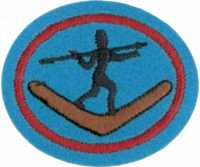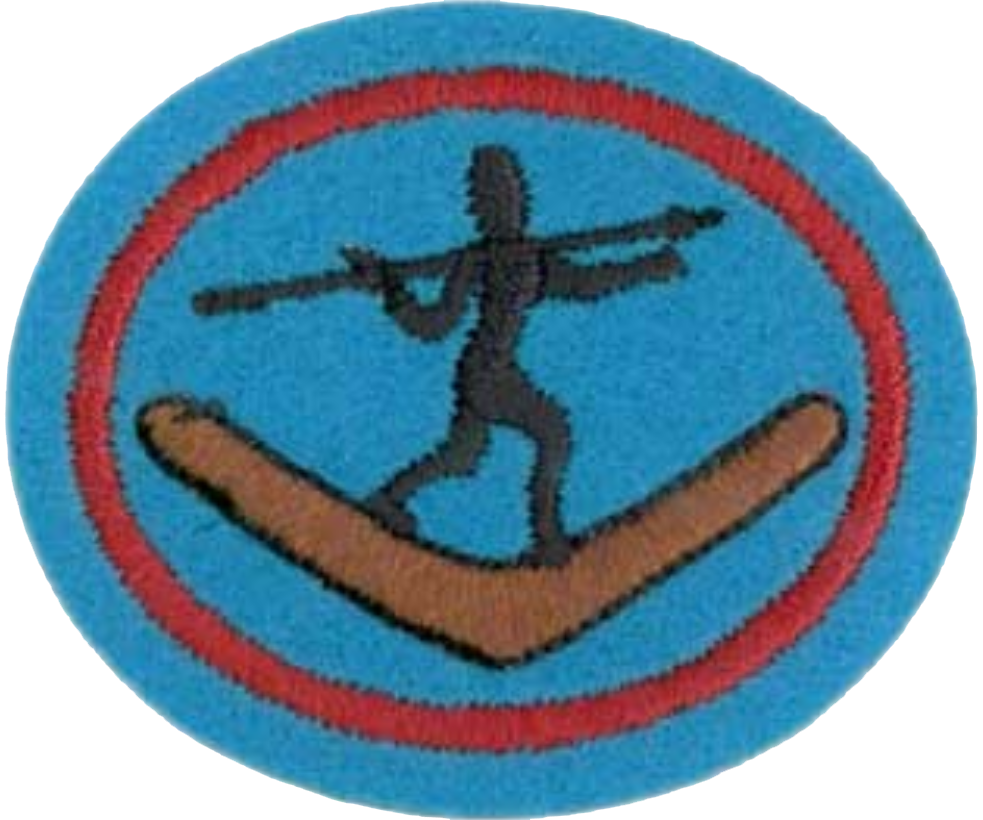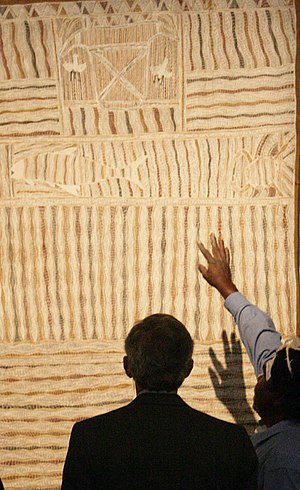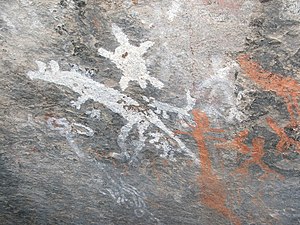Especialidades JA/Tradição aborígene/Respostas
Nível de Habilidade
1
Ano
2001
Version
05.05.2024
Autoridade de Aprovação
Conferência Geral
1
2
3
3a
3b
3c
4
5
6
7
Originally, the word waddy referred to a tree, or any piece of wood, as well as a verb meaning to 'beat up or kill with a club'.
8
Corroboree
A corroboree is a ceremonial meeting of Australian Aborigines. The word was coined by the European settlers of Australia in imitation of the Aboriginal word caribberie. At a corroboree Aborigines interact with the Dreamtime through dance, music and costume. Many ceremonies act out events from the Dreamtime. Many of the ceremonies are sacred and people from outside a community are not permitted to participate or watch.
In the northwest of Australia, corroboree is a generic word to define theatrical practices as different from ceremony. Whether it be public or private, ceremony is for invited guests. There are other generic words to describe traditional public performances: juju and kobbakobba for example. In the Pilbara, corroborees are yanda or jalarra. Across the Kimberley the word junba is often used to refer to a range of traditional performances and ceremionies.
Corroboree and ceremony are strongly connected but different. In the 1930s Adolphus Elkin wrote of a public pan-Aboriginal dancing "tradition of individual gifts, skill, and ownership" as distinct from the customary practices of appropriate elders guiding initiation and other ritual practices. Corroborees are open performances in which everyone may participate taking into consideration that the songs and dances are highly structured requiring a great deal of knowledge and skill to perform.
Corroboree is a generic word to explain different genres of performance which in the northwest of Australia include balga, wangga, lirrga, junba, ilma and many more. Throughout Australia the word corroboree embraces songs, dances, rallies and meetings of various kinds. In the past a corroboree has been inclusive of sporting events and other forms of skill display. It is an appropriated English word that has been reappropriated to explain a practice that is different to ceremony and more widely inclusive than theatre or opera.
Clap sticks and the didgeridoo
Aboriginal people developed unique instruments and folk styles. The didgeridoo is commonly considered the national instrument of Aboriginal people, and it is claimed to be the world's oldest wind instrument. However, it was traditionally only played by Arnhem Land people, such as the Yolngu, and then only by the men. It has possibly been used by the people of the Kakadu region for 1500 years. Clap sticks are probably the more ubiquitous musical instrument, especially because they help maintain the rhythm for the song.
9
Games
Marn Grook (also spelt marngrook), literally meaning "Game ball", is the collective name given to a number of traditional Indigenous Australian ball games believed to have been played at gatherings and celebrations of up to 50 players.
The earliest accounts, mostly from the colonial Victorian explorers and settlers, date back to just prior to the Victorian gold rush in the mid 1800s, but the game is suspected to have been played for many thousands of years. This connection justifies the claim of Australian Rules Football as being one of the oldest games still played today, albeit changed.
Regarding the playing of the game:
- There was no scoring;
- Teams could consist of extremely large numbers of players;
- Games were played over an extremely large area;
- The main object appears to have been to have fun, although good passages of play by individual players was usually commented upon; this particularly applied to high marking.
Marn Grook is especially notable as it is claimed by some to have had an influence on the modern game of Australian rules football, most notably in the catching of the kicked ball (the mark in Australian football) and, in particular, high jumping (the spectacular mark in Australian football) exhibited by the players of both games.
The 1858 Australian Rules game between Scotch College and Melbourne Grammar School, which is believed by most historians to have been the first Australian Rules game, included a number of the features of Marn Grook; in particular, the large number of players and the large area of play (the 1858 game had goals that were 500 metres apart). Both of these features disappeared from Australian Rules after the first rules were drawn up in 1859.
Training, Initiation, and Bora
A Bora is the name given both to an initiation ceremony, and to the site on which the initiation is performed. At such a site, young boys are transformed into men. The initiation ceremony differs from culture to culture, but often involves circumcision and scarification, and may also involve the removal of a tooth or part of a finger. The ceremony, and the process leading up to it, involves the learning of sacred songs, stories, dances, and traditional lore. Many different clans will assemble to participate in an initiation ceremony.
The word Bora was originally from South-East Australia, but is now often used throughout Australia to describe an initiation site or ceremony. It is called a Burbung in the language of the Darkinjung, to the North of Sydney. The name is said to come from that of the belt worn by initiated men. The appearance of the site varies from one culture to another, but it is often associated with stone arrangements, rock engravings, or other art works. Women are generally prohibited from entering a bora.
In South East Australia, the Bora is often associated with the creator-spirit Baiame. In the Sydney region, large Earth mounds were made, shaped as long bands or simple circles. Sometimes the boys would have to pass along a path marked on the ground representing the transition from childhood to manhood, and this path might be marked by a stone arrangement or by footsteps, or mundoes, cut into the rock. In other areas of South-East Australia, a Bora site might consist of two circles of stones, and the boys would start the ceremony in the larger, public, one, and end it in the other, smaller, one, to which only initiated men are admitted.
Bora rings, found in South-East Australia, are circles of foot-hardened earth surrounded by raised embankments. They were generally constructed in pairs (although some sites have three), with a bigger circle about 22 metres in diameter and a smaller one of about 14 metres. The rings are joined by a sacred walkway.
Bull Roarer
The bullroarer is an ancient ritual musical instrument and means of communicating over extended distances. Along with the didgeridoo, it is prominent technology among Australian Aborigines, used in ceremony across the continent.
Bullroarers have accompanied the didgeridoos in initiation ceremonies and in burials to ward off evil spirits, bad tidings, and even women and children.
Bullroarers are considered secret men's business by some Aboriginal tribal groups, and hence taboo for women, children, non-initiated men and/or outsiders to even hear. They are used in men's initiation ceremonies and the sound they produced is considered by some Indigenous cultures to represent the sound of the Rainbow Serpent. In the cultures of South-East Australia, the sound of the bullroarer is the voice of Daramulan, and a successful bullroarer can only be made if it has been cut from a tree containing his spirit.
Bullroarers have sometimes been referred to as "wife-callers" by Australian Aborigines.
A bullroarer is used by Paul Hogan in the 1988 film Crocodile Dundee II.
10
There are many "types" of Aboriginal art, but the two most famous types appear to be bark painting and rock art.
Bark Painting
Bark painting is an Australian Aboriginal art-form which is done on the interior strip of a tree bark. Traditionally, bark paintings were produced for instructional and ceremonial purposes and were transient objects. Today, they are keenly sought after by collectors and public arts institutions.
The barest necessities for bark artwork are paint, brushes, bark, fixative and a fire.
The material of choice is the bark from Stringybark (Eucalyptus tetradonta). The bark chosen must be free of knots and other blemishes. It is best cut from the tree in the wet season when the sap is rising. Two horizontal slices and a single vertical slice are made into the tree, and the bark is then carefully peeled off with the aid of a sharpened tool. Only the inner smooth bark is kept and placed in a fire. After heating in the fire, the bark is flattened under foot and weighted with stones or logs to dry flat. The 'canvas' is then ready to paint upon.
Earth pigments - or ochres - in red, yellow and black are used and are mineral oxides of iron and manganese. White pipeclay, or calcium carbonate, is also used. Ochres may be fixed with a binder such as PVA glue, or in the old days, with the sap or juice of plants such as orchid bulbs.
After the painting is completed, the bark is splinted at either end to keep the painting flat. A fixative, traditionally orchid juice, is added over the top.
The sacred designs on which bark paintings are based included abstract patterns and designs (such as cross-hatching in particular colours) which identify a clan, and also often contain elements of the Eternal Dreamtime. Sometimes the elements of a story are obvious - such as those depicting men or animals - but sometimes the elements are symbolic. What appears to the tourist as a series of wavy lines punctuated by dots may actually be telling a complex Dreaming story describing the path of a creator spirit, and the events that happened along the way.
An uninitiated man or woman is only allowed to paint outside stories - in other words, the sort of story that might be told to a child. An initiated man can paint an inside story, which is itself restricted knowledge. Thus a painting may be displayed in an exhibition, or put up for sale, but the artist, although having the right to paint the story, does not have the right to tell the story to another person. Alternatively, the story behind the painting may be one which cannot be told to an uninitiated person.
Rock Art
Indigenous art includes a range of styles of rock painting:
- The cross-hatch or X-ray art from the Arnhem Land and Kakadu regions of the Northern Territory, in which the skeletons and viscera of the animals and humans portrayed are drawn inside the outline, as if by cross section.
- Dot-painting where intricate patterns, totems and/or stories are created using dots; and
- Stencil art, particularly using the motif of a hand print.
More simple designs of straight lines, circles and spirals, are also common, and in many cases are thought to be the origins of some forms of contemporary Aboriginal Art.
A particular type of Aboriginal painting, known as the Bradshaws, appears on caves in the Kimberley region of Western Australia. They are named after the European pastoralist, Joseph Bradshaw, who first reported them in 1891. To Aboriginal people of the region they are known as Gwion Gwion. Traditional Aboriginal art is composed of organic colours and materials, but modern artists often use synthetic paints when creating aboriginal styles.
11
1788-1900
In 1770, Lieutenant James Cook claimed the east coast of Australia in the name of Great Britain and named it New South Wales. British colonisation of Australia began in Sydney in 1788. The most immediate consequence of British settlement – within weeks of the first colonists' arrival – was a wave of European epidemic diseases such as chickenpox, smallpox, influenza and measles, which spread in advance of the frontier of settlement. The worst-hit communities were the ones with the greatest population densities, where disease could spread more readily. In the arid centre of the continent, where small communities were spread over a vast area, the population decline was less marked.
The second consequence of British settlement was appropriation of land and water resources. The settlers took the view that Indigenous Australians were nomads with no concept of land ownership, who could be driven off land wanted for farming or grazing and who would be just as happy somewhere else. In fact the loss of traditional lands, food sources and water resources was usually fatal, particularly to communities already weakened by disease. Additionally, Indigenous Australians groups had a deep spiritual and cultural connection to the land, so that in being forced to move away from traditional areas, cultural and spiritual practices necessary to the cohesion and well-being of the group could not be maintained. Settlers also brought alcohol, opium and tobacco, and substance abuse has remained a chronic problem for indigenous communities ever since. The combination of disease, loss of land and direct violence reduced the Aboriginal population by an estimated 90% between 1788 and 1900. Entire communities in the moderately fertile southern part of the continent simply vanished without trace, often before European settlers arrived or recorded their existence.
As the European pastoral industries developed, several economic changes came about. The appropriation of prime land and the spread of European livestock over vast areas made a traditional indigenous lifestyle less viable, but also provided a ready alternative supply of fresh meat for those prepared to incur the settlers' anger by hunting livestock. The impact of disease and the settlers' industries had a profound impact on the Indigenous Australians' way of life. With the exception of a few in the remote interior, all surviving indigenous communities gradually became dependent on the settler population for their livelihood. In south-eastern Australia, during the 1850s, large numbers of white pastoral workers deserted employment on stations for the Australian goldrushes. Indigenous women, men and children became a significant source of labour. Most indigenous labour was unpaid, instead indigenous workers received rations in the form of food, clothing and other basic necessities. In the later 19th century, settlers made their way north and into the interior, appropriating small but vital parts of the land for their own exclusive use (waterholes and soaks in particular), and introducing sheep, rabbits and cattle, all three of which ate out previously fertile areas and degraded the ability of the land to carry the native animals that were vital to indigenous economies. Indigenous hunters would often spear sheep and cattle, incurring the wrath of graziers, after they replaced the native animals as a food source. As large sheep and cattle stations came to dominate northern Australia, indigenous workers were quickly recruited. Several other outback industries, notably pearling, also employed Aboriginal workers.
In many areas Christian missions provided food and clothing for indigenous communities and also opened schools and orphanages for indigenous children. In some places colonial governments provided some resources
After 1900
In spite of the impact of disease, violence and the spread of foreign settlement and custom, some indigenous communities in remote desert and tropical rainforest areas survived according to traditional means until well into the 20th century. Although missionary life was, by 1914, in retrospect absent of any meaning, most free men supported the war effort and around 1200[citation needed] answered the call to arms. Restrictions on Aborigines serving in the military were not relaxed until 1917, but many enlisted by claiming they were Māori or Indian.
By the 1920s, the indigenous population had declined to between 50,000 and 90,000, and the belief that the Indigenous Australians would soon die out was widely held, even among Australians sympathetic to their situation. But by about 1930, those Indigenous Australians who had survived had acquired better resistance to imported diseases, and birthrates began to rise again as communities were able to adapt to changed circumstances.
In the Northern Territory, significant frontier conflict continued. Both isolated Europeans and visiting Asian fishermen were killed by hunter gatherers until the start of World War II in 1939. It is known that some European settlers in the centre and north of the country shot indigenous people during this period. One particular series of killings became known as the Caledon Bay crisis, and became a watershed in the relationship between indigenous and non-indigenous Australians.
By the end of World War II, many indigenous men had served in the military. They were among the few indigenous Australians to have been granted citizenship; even those that had were obliged to carry papers, known in the vernacular as a "dog licence", with them to prove it. However, Aboriginal pastoral workers in northern Australia remained unfree labourers, paid only small amounts of cash, in addition to rations, and severely restricted in their movements by regulations and/or police action. On May 1, 1946, Aboriginal station workers in the Pilbara region of Western Australia initiated the 1946 Pilbara strike and never returned to work. However, this protest came as modern technology and management techniques were starting to dramatically reduce the amount of labour required by pastoral enterprises. Mass layoffs across northern Australia followed the Federal Pastoral Industry Award of 1968, which required the payment of a minimum wage to Aboriginal station workers. Many of the workers and their families became refugees or fringe dwellers, living in camps on the outskirts of towns and cities.
In 1984, a group of Pintupi people who were living a traditional hunter-gatherer desert-dwelling life were tracked down in the Gibson Desert in Western Australia and brought in to a settlement. They are believed to be the last uncontacted tribe in Australia.
The path to reconciliation: 1967 onwards
Indigenous Australians were given the right to vote in Commonwealth elections in Australia in November 1963, and in state elections shortly after, with the last state to do so being Queensland in 1965. The 1967 referendum, passed with a 90% majority, allowed the Commonwealth to make laws with respect to Aboriginal people, and for Aboriginal people to be included in counts to determine electoral representation. This has been the largest affirmative vote in the history of Australia's referendums.
In 1971, Yolngu people at Yirrkala sought an injunction against Nabalco to cease mining on their traditional land. In the resulting historic and controversial Gove land rights case, Justice Blackburn ruled that Australia had been terra nullius before European settlement, and that no concept of Native title existed in Australian law. Although the Yolngu people were defeated in this action, the effect was to highlight the absurdity of the law, which led first to the Woodward Commission, and then to the Aboriginal Land Rights Act.
In 1972, the Aboriginal Tent Embassy was established on the steps of Parliament House in Canberra, in response to the sentiment among indigenous Australians that they were "strangers in their own country". A Tent Embassy still exists on the same site.
In 1975, the Whitlam government drafted the Aboriginal Land Rights Act, which aimed to restore traditional lands to indigenous people. After the dismissal of the Whitlam government by the Governor-General, a reduced-scope version of the Act (known as the Aboriginal Land Rights Act 1976) was introduced by the coalition government led by Malcolm Fraser. While its application was limited to the Northern Territory, it did grant "inalienable" freehold title to some traditional lands.
In 1992, the Australian High Court handed down its decision in the Mabo Case, declaring the previous legal concept of terra nullius to be invalid. This decision legally recognised certain land claims of Indigenous Australians in Australia prior to British Settlement. Legislation was subsequently enacted and later amended to recognise Native Title claims over land in Australia.
In 1998, as the result of an inquiry into the forced removal of indigenous children (see Stolen generation) from their families, a National Sorry Day was instituted, to acknowledge the wrong that had been done to indigenous families. Many politicians, from both sides of the house, participated, with the notable exception of the Prime Minister, John Howard.
In 1999 a referendum was held to change the Australian Constitution to include a preamble that, amongst other topics, recognised the occupation of Australia by Indigenous Australians prior to British Settlement. This referendum was defeated, though the recognition of Indigenous Australians in the preamble was not a major issue in the referendum discussion, and the preamble question attracted minor attention compared to the question of becoming a republic.
In 2008 the prime minister of Australia Keven Rudd, made an official apology to the Indigenous Australians for the years of misery that they suffered. Although nothing has been done in actual way of legislation and such, this is the first step in bridging the gap between the two cultures.
References
- Two groups may have populated Australia
- How Aboriginal Children Grow Up, by Michael Sawtell.




